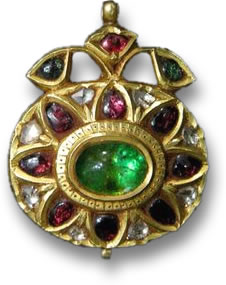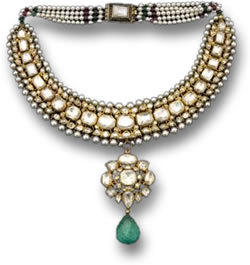|
Reviewed By Andreas Zabczyk
Indian Kundan Gemstone Jewelry
Mughal Kundan Pendant
The Sanskrit word, "kundan" means "gold". Traditional kundan jewelry is gemstone jewelry set into 24 karat gold. The style originated in Gujarat and Rajasthan during the Mughal Empire. Mughal jewelry designs became so popular that they spread to other parts of India. An example of such influence can be seen in the jewels of the Nizams of Hyderabad. The fusion of Mughal Islamic art and Indian goldworking is what makes kundan jewelry unique. The intricate crafting skills required to produce kundan jewelry have been honed by generations of expert Indian craftsmen. Crafting kundan jewelry involves first making a thin, gold sheet setting, which will be the base for the piece of jewelry. Next, resin (usually a tree sap known as "lac") is used to place the gems onto the sheet of gold. More gold foil is then inserted around the sides of the gems in layers, and it may be heated to join it all. Finally, the framework is welded to the base with more gold and then the piece is cleaned up. Kundan jewelry may also employ enameling to embellish the reverse side. This is known as "meenakari" and is done by first engraving the metal surfaces and then carefully cleaning the surfaces. The engravings are then filled with enamel glass powder. The enamel is then heated to fuse and set it, and finally, it is polished. The colors are heated in order of hardness; the hardest are heated first. After it is polished, the piece is ready for the stone setter. Kundan jewelry with meenakari work can sometimes be worn back-to-front. This is because the gemstones can be displayed on the front and the colored enamel can be seen on the reverse side. Kundan jewelry was worn by members of the Rajasthan royalty and the Mughal court, and is now popular with Indian brides. The gems traditionally used in kundan jewelry are diamonds, pearls, rubies and emeralds. They were not faceted in the modern style, which was not yet developed at the time of the Mughal Empire, but were unfaceted or carved gemstones. The 2008 movie, "Jodhaa Akbar", a love story of a Mughal emperor and a Rajput princess showcased the beautiful craftsmanship of India and made kundan jewelry more popular. With the high price of gold and demand for kundan jewelry, imitation kundan jewelry is also made from less valuable metals and glass gemstones. This means that many affordable kundan decorations can be bought for everyday items, such as mobile phone covers, hair pins and even shoes. 
Mughal Kundan Necklace
Traditional kundan jewelry is still produced by artisans in Jaipur, Rajasthan, which has been an important Indian gemstone and jewelry hub since the Mughal Empire. Kundan jewelry crafting is performed by teams of skilled jewelry designers, goldsmiths, gem setters and stone cutters. Modern kundan jewelry makes use of faceted stones, silver, gold plating, alternative metals and glass gemstones. The use of inexpensive materials makes kundan work accessible to all modern women, while the continued use of 24 karat gold and precious gemstones means that the original form is preserved. Kundan jewelry can take the form of a simple pendant, a nose ring, earrings, anklets, bracelets or a statement necklace. These are also sold in sets. For those wishing to capture the splendor and extravagance of the Mughal court, kundan jewelry certainly brings the bling. This Page in Other Languages
|
| STAY IN TOUCH | NEWSLETTER |
| *You're signing up to receive GemSelect promotional email. |
Copyright © 2005-2024 GemSelect.com all rights reserved.
Reproduction (text or graphics) without the express written consent of GemSelect.com (SETT Company Ltd.) is strictly prohibited.
2708